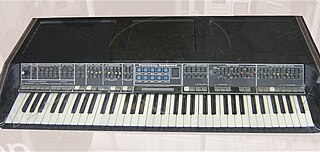General MIDI is a standardized specification for electronic musical instruments that respond to MIDI messages. GM was developed by the American MIDI Manufacturers Association (MMA) and the Japan MIDI Standards Committee (JMSC) and first published in 1991. The official specification is available in English from the MMA, bound together with the MIDI 1.0 specification, and in Japanese from the Association of Musical Electronic Industry (AMEI).

ARP Instruments, Inc. was a Lexington, Massachusetts manufacturer of electronic musical instruments, founded by Alan Robert Pearlman in 1969. It created a popular and commercially successful range of synthesizers throughout the 1970s before declaring bankruptcy in 1981. The company earned a reputation for producing excellent sounding, innovative instruments and was granted several patents for the technology it developed.

The ARP Odyssey is an analog synthesizer introduced by ARP Instruments in 1972.

The ARP 2600 is a subtractive synthesizer first produced by ARP Instruments, Inc in 1971.

Infrared Roses is a live compilation album by the Grateful Dead. It is a conglomeration of their famous improvisational segments "Drums" and "Space".

The ARP Pro Soloist was one of the first commercially successful preset synthesizers. Introduced by ARP Instruments, Inc. in 1972, it replaced the similar ARP Soloist (1970–1971) in the company's lineup of portable performance instruments.

The Polymoog is a hybrid polyphonic analog synthesizer that was manufactured by Moog Music from 1975 to 1980. The Polymoog was based on divide-down oscillator technology similar to electronic organs and string synthesizers of the time.
The Solina String Synthesizer, also erroneously known as the ARP Solina String Synthesizer or sometimes the ARP String Synthesizer, is a combination of a string synthesizer and synthesizer. It is a hybrid model which combined both the Solina String Ensemble string synthesizer and the ARP Explorer monophonic synthesizer. It was built in Bodegraven, Netherlands by Eminent B.V. Supposedly only about 100 were ever produced. The addition of the ARP Explorer to the Solina string sounds made for a very powerful combination.

The ARP Omni was a polyphonic analog synthesizer manufactured by ARP Instruments, Inc.
Electronic Dream Plant (EDP) was a small British synthesizer manufacturer, active during the late 1970s and early 1980s. At the time their products were not particularly successful commercially. In later years products like the "WASP" became prized by collectors for their unique sound, and later synthesizer companies have successfully copied some of their design elements.

The SH-3A is a monophonic analog synthesizer that was manufactured by Roland from 1975 to 1981. It is unique in that it is capable of both the usual subtractive synthesis and also the less common additive synthesis, offering mixable waveforms at different footages. Two LFOs and a unique sample-and-hold section provided capabilities not found in competing self-contained synthesizers of the time. The SH-3A was Roland's first non-preset based synth. The predecessor, the Roland SH-1000, could also do this but didn't offer as much control as on the SH-3A. The rhythmic pulsing in the Blondie song "Heart of Glass" is an example of its sound.
The Roland GR-500 is a guitar synthesizer. Manufactured by the Roland Corporation and FujiGen in 1977, it was one of the first guitar synthesizers.

Man-Child is the fifteenth studio album by jazz pianist Herbie Hancock. The record was released on August 22, 1975 by Columbia Records. It was the final studio album to feature The Headhunters, and a number of guest musicians including saxophonist Wayne Shorter, a full brass section, three different guitarists, and Stevie Wonder on harmonica.
The Roland Alpha Juno series of discontinued keyboards are analog polyphonic synthesizers with a digitally controlled oscillator manufactured by Roland Corporation from 1985 to 1987.

The Sirius is a keyboard "groove-synth," featuring a subtractive hybrid-tone-generation synthesizer referred to as DTE synthesis introduced in 1997 by Quasimidi. The unit featured both real-time and step sequencers with pattern- and song-modes, capable of acting basic drum machine, groove-box, or sound-module.

The Quasimidi Polymorph sequencer and synthesizer was released by Quasimidi in 1999. The synthesiser is a full featured and powerful Analog emulation synthesizer that assumes an evolved form and purpose of its predecessor - the Quasimidi Rave-O-Lution 309 which was released in 1996.
Rebecca Saunders is a London-born composer who lives and works freelance in Berlin. In a 2017 Classic Voice poll of the greatest works of art music since 2000, Saunders' compositions received the third highest total number of votes (30), surpassed only by the works of Georg Friedrich Haas (49) and Simon Steen-Andersen (35). In 2019, writers of The Guardian ranked Skin (2016) the 16th greatest work of art music since 2000, with Tom Service writing that "Saunders burrows into the interior world of the instruments, and inside the grain of Fraser's voice [...] and finds a revelatory world of heightened feeling."

Harmony is the third album by British-based American R&B/dance group Londonbeat, released in 1992 on the Anxious label. Although less successful than its predecessor In the Blood, Harmony produced two minor UK hits, "You Bring on the Sun" (#32) and "That's How I Feel About You" (#69). The former also reached the top 20 in Italy, Sweden, Norway, Switzerland and Austria.
The Korg Collection 4 is one of the largest collections of VST instruments from Korg and was released in 2004 with updates and more Synths added over time. The original 2004 release consists of the Korg MS-20, Korg Polysix and Korg Wavestation, and LegacyCell, a VST which layers combinations of any of the past 3 synths mentioned. In 2006, they added the Korg Mono/Poly, Korg M1, and Korg MDE-X Multi FX processor. On December 21, 2017, the ARP Odyssey was made into a VST and added to the collection, and the Korg Triton was added on for Christmas 2019. All of these synths were revamped in the spring of 2020 and renamed, collectively, the Korg Collection 2. With the addition of the Korg Triton Extreme, MiniKORG 700s and Korg Prophecy, it was renamed the Korg Collection 3.












